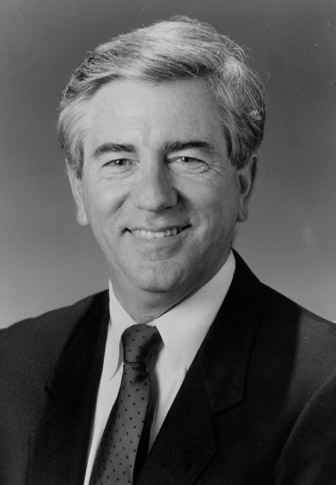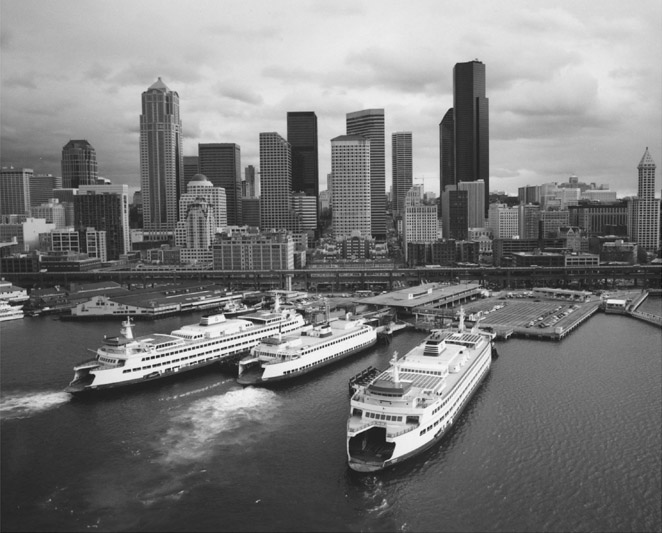Bay CrossingsNews
A Tour of the Washington Ferry System
By Paul Greene
 Paul Greene is Director of the Washington State Ferry System Paul Greene is Director of the Washington State Ferry System
Our Seattle-area ferries are a
top tourist attraction, and like the Space Needle, a true icon of the Northwest.
They connect the people of the Puget Sound region to jobs, bring goods to
markets, and provide services to all within a major metropolitan area. The WSF
spends a large part of the day taking people to and from work in Seattle and to
other places like the Bremerton Shipyard. For the communities on Vashon Island
and the San Juan Islands, the ferries provide the only link for vehicles to the
mainland. The WFS system operates both as an extension of the state’s highway
system and as a highly efficient provider of mass transportation.
Washington State Ferries operates 20 terminals, 24
vehicle/passenger ferries, and five (5) passenger-only ferries. Included in
these numbers are the latest additions: two high-speed passenger-only vessels
from Dakota Creek Shipyards that carry 350 passengers at 36 knots and three
Jumbo Mark II vehicle/passenger ferries, constructed at Todd Pacific Shipyards,
with a service speed of 18 knots, that carry 2,500 passengers and 218 vehicles.
Both vehicle and passenger ridership is projected to grow
faster than the general population. Over the next 20 years, the population of
the four county central Puget Sound metropolitan region is projected to increase
by more than 2 million residents. Traffic on certain routes within the central
Puget Sound corridor is expected to more than double. WSF expects that daily
demand for ferry travel will increase by an average of 70 percent by 2015.
The Kitsap Peninsula and the islands on the west side of
Puget Sound are primarily residential, while Seattle is the employment
attraction. This imbalance will persist over the next 20 years putting enormous
pressure on during peak periods and causing capacity pressure, as well as
schedule reliability pressure, for customers commuting to and from work. WSF
anticipates that the walk-on percent of traffic carried will increase from 41
percent to 55 percent in 2015. This will put more pressure on landside transit
and parking infrastructure. The goals of the program are to take advantage of
the development of high-speed passenger carrying technology to allow new, longer
routes to become feasible and balance cross Sound traffic flows out over several
routes instead of focusing on one or two high-density corridors. Also, the speed
advantage is a further inducement to attracting commuters out of their
automobiles into the walk-on mode of travel.
|
Washington
Ferry System — A Likely Model for the Bay Area’s Regional Ferry
System |
| By
Jodi Ketelsen & Doug Playter
Jodi Ketelsen, an Alameda resident and ferry rider,
has more than 10 years’ experience achieving consensus on
transportation improvement and community development projects. Doug
Playter is a transportation engineer who specializes in port facilities.
He was design manager of both landside and off-shore marine facilities
for Washington State Ferries, and he is currently lead engineer for
design of a multimodal transportation center in Edmonds, Washington.
Both Ms. Keletsen and Mr. Playter work for CH2M Hill, the large
consulting firm.
A number of transportation professionals and ferry
operators recently attended a conference on ferry transportation
planning hosted by the United States Department of Transportation (USDOT).
This timely conference was held as our own San Francisco Bay Regional
Water Transit Authority is organizing to form the nine-county Bay Area
regional ferry system.
Seattle was an ideal setting for this meeting.
Washington State Ferries (WSF) is the largest ferry system in North
America and one of the world’s busiest. This system provides a
near-perfect model for the Bay Area to investigate, not least because of
the important parallels between the two metropolitan areas. Both
locations are on the same coast, have similar demographics and are
seeing similar land use development patterns. The San Francisco Bay is
approximately 60 miles long and fairly narrow, and the Puget Sound is 80
miles long and fairly narrow. The central geographical difference is in
the water depth; whereas Puget Sound has all deep-water channels San
Francisco Bay is half deep-water and half very shallow bay lands. Both
areas include strong, centrally located world-class cities and many
tourist attractions. Also, both areas are served by an extensive highway
infrastructure, as well as significant investments in public transit and
ferry systems. The nine-county Bay Area population is reaching 7 million
people. In contrast, the population of the metropolitan area surrounding
Seattle is only 3.19 million.
However, unlike the Bay Area existing ferry systems,
the WSF system has been funded and operated by the state government. The
Bay Area has government-funded terminals, some public service but also
significant private operation of ferryboat service. Furthermore, the WSF
reports to the state secretary, who in turn reports to a Transportation
Commission composed of seven members appointed by the Governor and
approved by the Senate. The Transportation Commission sets policy and
tariffs for the ferry system; however, in reality, WSF has a second
Board of Directors, the Washington State Legislature, which funds the
capital and operating programs.
All considered, the WFS is considered a public transportation
success. WSF’s success is seen in the numbers. In 1999, Washington
State Ferries carried 26.5 million passengers, or 20 percent of all
ferry riders in the world. On a daily basis, that amounts to 74,000
passengers. During the summer months, this amount increases to 93,000
passengers a day. As a point of comparison, the local airport
(Seattle-Tacoma International) flew 27 million passengers last year.
Furthermore, Amtrak carried 21 ½ million passengers nationwide. |
Issues that the Washington Ferry System Faces
Environmental Permitting
There are increasing levels of regulations that affect most
every facet of ferry business: landside regulations in the form of federal
transportation planning rules; state growth-management rules requiring
conformance to regional transportation plans; the vast array of local
regulations governing land use, transportation and traffic, and building
permits; and federal and state environmental regulations and state and local
shoreline permitting processes involving multiple agencies often with
conflicting goals. Furthermore, in addition to the Coast Guard, the WSF must
work with two other organizations (Labor & Industries and Ecology) that have
regulatory powers over WSF’s vessels.
WSF has used key environmental/design consultants such as
CH2M HILL to weave through the planning and landside permit process, which
is much more complex than vessel permitting. As with any ferry service, WSF,
depends on landside facilities and their accessibility to customers, whether it
is via transit, vehicular or even pedestrian movements.
Safety
The WSF system has an established record of safety, having
never experienced a passenger fatality in our 49 years of operation. But as we
all know, other ferry operators throughout the world do not share this level of
passenger safety. Washington State Transportation Commission and the State
legislature formed a Blue Ribbon Panel on Ferry Safety, which resulted in a
detailed computer-based risk assessment model and 16 recommended action items.
WSF is in various stages of implementing those recommendations that focus on
elements of improved risk reduction and emergency response.
Those efforts include:
» Establishment
of a 7-days-a-week, 24-hour-a-day Watch Center with the appropriate
communications suite.
» Capability to monitor
the position of all our vessels.
» Establishment of
emergency response teams trained in Incident Command System procedures outreach
initiative to all Emergency Response providers in the Northwest.
Customer Service
The ferry business is a customer service business. One way
WSF assesses success is through the collection and analysis of comments made by
our customers. In 1999, WSF received less than 10 complaints per 100,000 riders.
Like every other business, the Internet is becoming an
essential tool to fulfilling customers’ expectations. In addition to providing
WSF’s schedule, fares, expected boarding wait times, and a real-time depiction
of where our in-service vessels are, the Internet provides the platform for our
schedule disruption e-mail notification system. This system provides the
5,000-plus subscribers with real-time notification of a delay or disruption on
the routes in which they are interested. . With palmcorders and digital read-out
pagers, the communication capability can be as close as their briefcase, purse,
or hip.
Operating
Performance
Second only to safety, schedule reliability is the most
important element in WSF’s service. Over the past 5 years, WSF has completed
more than 99.4% of our scheduled 744,000 trips.
On-time performance continues to grow in importance as more
customers make the modal shift out of automobiles. WSF has made on-time
performance a fleet priority, but we are just beginning to get the necessary
technology in place to capture and analyze this data in the same fashion as
schedule completion.
Financial
Responsibility
The recent approval of ballot measure 695 drastically changed
the financial reality for WSF, creating even more pressure to be financially
efficient. Over the next 6 years, the motor vehicle excise tax would have
represented 25 percent of WSF’s operating revenues, leaving a $254 million
gap. The capital picture is worse. The motor vehicle excise tax was to account
for 77 percent of WSF capital revenue over 6 years, or a $614 million hole in
the capital budget.
Yet consider how lean WSF service already is. Over the last 6
years, WSF carried 3 million new passengers and 1.5 million additional vehicles
while reducing operating costs per passenger and per vehicle. Overall,
the ferry system has a fair box recovery of 60 percent of operating cost. In
comparison, most public transportation systems recover less than 30 percent of
operating expenses.
On average, WSF’s vessels are 30 years old and many of the
terminals are over 40. A 20-year capital requirements analysis showed a need for
$2.5 billion. With respect to managing capital, WSF has implemented a
two-pronged initiative. The first involves a comprehensive life-cycle analysis
program for both vessels and terminals to guide our preservation investments and
ensure priority terminal structures and vessel systems are replaced when they
reach the end of their life expectancies. The second is a concerted effort to
improve vessel and terminal contract management.
The capital picture is worse. The motor vehicle excise tax
accounted for 77 percent of our capital revenue over 6 years. Initiative 695
created a $614 million hole in our capital budget. As a matter of fact, we do
not have enough capital funds remaining to cover our existing debt obligations.
During their most recent session, the Washington State
legislature funded most of our capital and operating needs for the balance of
this budget cycle which ends on June 30, 2001.
However, the future of the ferry system beyond that date
depends on the legislature finding a permanent funding solution. To that end, a
legislatively mandated task force has been created to evaluate and recommend
alternatives to this funding crisis. Their report is due to lawmakers in Olympia
next January.
For as bleak as our future may appear, I believe our elected
officials will find the resolve to address this problem. Washington State
Ferries is too important to our state and the Seattle region in particular to
expect any less.
Long a vital means of transportation in areas with major
lakes, bays and sounds, ferry travel is re-emerging once again as a major link
in our nation’s transportation system. Bridges in the late 1800’s and much
of the 1900’s replaced many ferry operations. Recently, ferry travel has seen
a resurgence as the nation’s population has grown and land based
transportation systems have become increasingly congested. The development of
fast ferry technology enables much more creative deployment of vessels to
provide viable alternatives to clogged landside roads and mass transit systems.
More than ever, ferry transportation plays a vital role in this country’s
economic framework. More than ever, ferry transportation is an effective and
efficient means of moving large numbers of people. And ferry transportation is
as vital now as it was 100 years ago when the mosquito fleet first plied the
waters of Washington state.
|